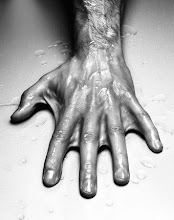
I was talking to my Mum on the phone about this and she had some questions which I will try and field. The first was about the thin layers of sponge which are so typical of French patisserie. They are around half a centimetre thick. It's not a thicker sponge cut down but actually made that thickness from the start. The sponge batter is simply spread out with a palette knife on a papered baking tray and cooked very quickly (c. 7mins).
Naturally, when you are dealing with something so thin, it also needs to be very regular or patches will burn. Learnt from experience.
The French word for this kind of sponge is, confusingly, biscuit. There are many different kinds which have slight variations in texture. They all combine flour with beaten egg whites. Some contain powdered almonds or gianduja while others are flavoured and coloured with cocoa powder. The biscuits we have looked at so far are biscuit à la cuillère, joconde, dacquoise, génoise and viennoise.
The printing around the edge is achieved with a coloured cigarette paste. You start with a silicone baking sheet, apply a layer of cigarette paste and comb it to form lines (red and wavy in the photo above). The sheet is then frozen and the biscuit proper is spread out thinly on top. The whole lot is baked on a doubled baking tray to prevent coloration underneath (i.e. where the printing is). My printed band above is really rather weak and you can easily see a tonne of air bubbles (despite my vigorous tappings of the baking tray before cooking). While you normally want your sponge as light as possible, for this use you need to take out quite a bit of air by stirring with a spatula otherwise you end up with massive pockets as demonstrated.
The chocolate mousse we used for this recipe is really interesting. A classic homemade choco mousse is simply molten chocolate folded into a French meringue (you might also add the liquid yolks to the molten chocolate). The meringue is what gives the mousse its lightness. This mousse, however, has 3 different lightening strokes: Italian meringue, a bomb mixture and whipped cream.
1. Italian meringue is discussed here. In essence, you mount your egg whites then firm them up with a syrup.2. 'Bomb mixture' is a pretty shoddy translation of the French, appareil à bombe. Or rather, it's an excellent literal translation but I think it's miles off the mark. Simply no idea what we call it in English. What one is, anyway, is mounted egg yolks (these take a lot longer to beat than egg whites) firmed up with a sugar syrup. In other words, an Italian meringue made with the yolks rather than the whites.3. Whipped cream speaks for itself.
Interestingly, when you combine an Italian meringue with a bomb mixture you are producing a parfait. And when you mix a parfait with whipped cream you are making a kind of sabayon (French for sabaglione). All in all, the resultant mousse is super light.
Half my class did pear and chocolate which also worked very well. I quite fancy trying beetroot and chocolate but I daren't tell my prof...

No comments:
Post a Comment